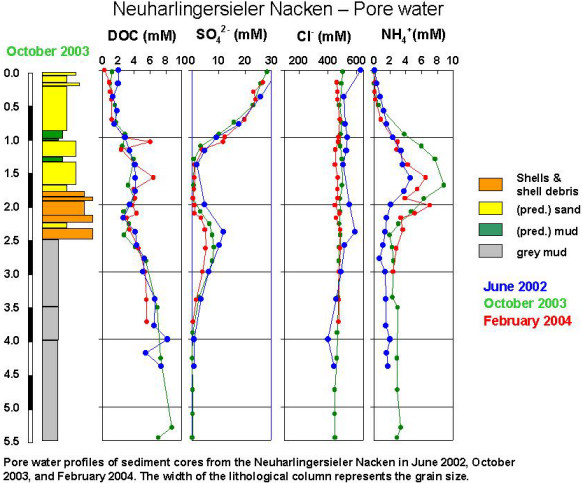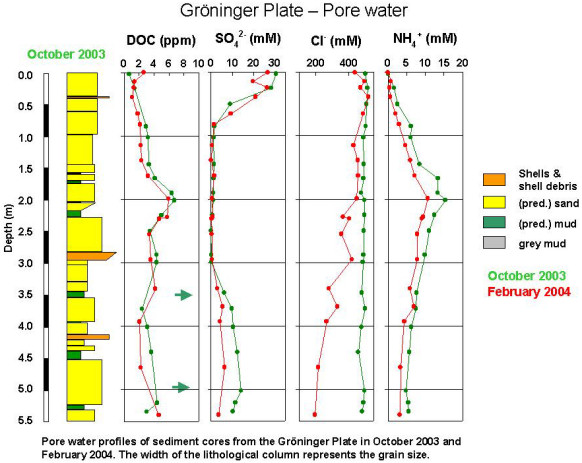
BioGeoChemistry of Tidal Flats
Pore water profiles in long sediment cores
At present, there is little knowledge about the composition and dynamics of pore water in deeper sediments layers of the Wadden Sea. Sediment cores up to 5.5 m depth show unexpectedly complex pore water profiles resulting from the interaction of microbial processes and pore water dynamics. Dissolved organic carbon slightly increases in core intervals with higher mud and total organic carbon contents. The sulfate concentrations display two maxima separated by a zone of sulfate depletion and maximum ammonium concentrations. Variations with time suggest that pore water profiles shaped by microbiological processes were modified by lateral inflow of sea water as well as mixing with sulfate- and chloride-depleted water.
We analysed pore water of Neuharlingersieler Nacken sediments in cores taken in June 2002, October 2003 and February 2004. Dissolved organic carbon (DOC, <0.2 &µm filtrate) increased with depth from <2 mM near the surface to ca. 7 mM in the mud-dominated unit in the lower part of the cores. Sulfate had a concentration of ca. 30 mM at the surface and was almost absent between 1.2 and 2 m depth. Surprisingly, a second asymmetric sulfate maximum occurred between 2 and 3.5 m (maximum ca. 9 mM) with a steep upward and gentle downward gradient. It is located in the shell layers and extends downward into the upper part of the underlying mud interval. Probably, the sulfate maxima at depth are caused by lateral inflow of sulfate-rich surface water from the Wadden Sea. The sulfate minimum zone was accompanied by a maximum concentration of ammonium up to 8 mM. Chloride decreased slightly with depth from ca. 500 to 450 mM. In June 2002 chloride concentrations at the sediment surface were slightly elevated, probably due to evaporation at low tide in summer.

At Gröninger Plate the pore water DOC showed a gentle maximum between 1.5 and 2.5 m (ca. 7 mM) associated with the occurrence of mud-rich layers with elevated contents of organic matter in this interval. Sulfate decreased within the upper 90 cm from ca. 30 mM at the surface to almost zero and was absent down to 3 m depth. Underneath, a second sulfate maximum occurred with values up to 14 mM extending downward to more than 5.5 m depth. Like in the cores from Neuharlingersieler Nacken ammonium concentrations showed a maximum (15 mM) in the zone where sulfate was absent, and decreased downward to ca. 5 mM. At this location the chloride concentrations below 2 m depth differ strongly in the cores from October 2003 and February 2004. This suggests that pore water was mixed with water depleted in sulfate and chloride by lateral inflow. DOC values were apparently not affected.

| <<back | All publications |